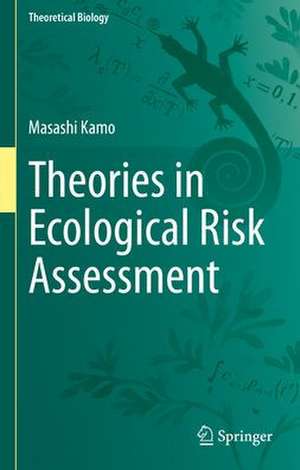Theories in Ecological Risk Assessment: Theoretical Biology
Autor Masashi Kamoen Limba Engleză Hardback – 5 mai 2023
The first part describes population-level assessment in ecological risk assessment. The chapters cover current methodologies for ecological risk assessment, individual-level assessment, population dynamics models for population-level assessment, case studies, mathematical models for population extinctions, the derivation of mean time to extinction (MTE) and their case studies. The second part of the book discusses the mathematical models involved in hazard assessments. It introduces the method of risk assessment using species sensitivity distributions (SSDs), hazard assessment of metals, chemical mixtures using the Michaelis-Menten equation, basic elements of statistics and related topics.
Expected readers are risk assessors in governments and public sectors, students and young researchers interested in environmental science. The book is made accessible and easy to follow by beginners in mathematical biology and theoretical ecology.
| Toate formatele și edițiile | Preț | Express |
|---|---|---|
| Paperback (1) | 467.42 lei 38-45 zile | |
| Springer Nature Singapore – 6 mai 2024 | 467.42 lei 38-45 zile | |
| Hardback (1) | 730.35 lei 3-5 săpt. | |
| Springer Nature Singapore – 5 mai 2023 | 730.35 lei 3-5 săpt. |
Preț: 730.35 lei
Preț vechi: 890.66 lei
-18% Nou
Puncte Express: 1096
Preț estimativ în valută:
139.76€ • 149.44$ • 116.52£
139.76€ • 149.44$ • 116.52£
Carte disponibilă
Livrare economică 28 martie-11 aprilie
Preluare comenzi: 021 569.72.76
Specificații
ISBN-13: 9789819903085
ISBN-10: 9819903084
Pagini: 202
Ilustrații: XIV, 202 p. 90 illus.
Dimensiuni: 155 x 235 mm
Greutate: 0.52 kg
Ediția:2023
Editura: Springer Nature Singapore
Colecția Springer
Seria Theoretical Biology
Locul publicării:Singapore, Singapore
ISBN-10: 9819903084
Pagini: 202
Ilustrații: XIV, 202 p. 90 illus.
Dimensiuni: 155 x 235 mm
Greutate: 0.52 kg
Ediția:2023
Editura: Springer Nature Singapore
Colecția Springer
Seria Theoretical Biology
Locul publicării:Singapore, Singapore
Cuprins
0. Introduction - Ecologist in Wonderland.- Part 1. Linking Ecotoxicology and Ecology.- Chapter 1. Basic Concepts of Ecological Risk Assessment.- Chapter 2. Population-level assessment.- Chapter 3. Population models of extinction.- Chapter 4. Population level assessment using the canonical model.- Part 2. Models for ecotoxicology.- Chapter 5. Species Sensitivity Distribution in Ecological Risk Assessment.- Chapter 6. BLM: A model for predicting metal toxicities.- Chapter 7.Mathematical models for chemical mixtures.- Chapter 8.Statistics and related topics.
Notă biografică
Masashi Kamo has been a researcher at the National Institute of Advanced Industrial Science and Technology (AIST), Research Institute of Science for Safety and Sustainability (RISS), Japan since 2004. His research interests include ecology, evolutionary biology, and risk assessment. In evolutionary biology, he is interested in topics such as the evolution of infectious diseases and uses various models to study and solve related problems. In risk assessment, he looks for topics that can be analyzed using mathematical models. This approach leads him to conduct research on a diverse range of topics within risk assessment.
Textul de pe ultima copertă
This book introduces various mathematical models used in ecological risk assessment, primarily discussing models used in hazard assessment. The book aims to link ecology and conservation biology with risk assessments, bringing together the knowledge of ecotoxicology and ecology for effective risk assessment.
The first part describes population-level assessment in ecological risk assessment. The chapters cover current methodologies for ecological risk assessment, individual-level assessment, population dynamics models for population-level assessment, case studies, mathematical models for population extinctions, the derivation of mean time to extinction (MTE) and their case studies. The second part of the book discusses the mathematical models involved in hazard assessments. It introduces the method of risk assessment using species sensitivity distributions (SSDs), hazard assessment of metals, chemical mixtures using the Michaelis-Menten equation, basic elements of statistics and related topics.
Expected readers are risk assessors in governments and public sectors, students and young researchers interested in environmental science. The book is made accessible and easy to follow by beginners in mathematical biology and theoretical ecology.
Expected readers are risk assessors in governments and public sectors, students and young researchers interested in environmental science. The book is made accessible and easy to follow by beginners in mathematical biology and theoretical ecology.
Caracteristici
Covers basic methods and various case studies of ecological risk assessments Describes mathematical models in an easy-to-follow manner Provides necessary knowledge and way of thinking for risk assessment








